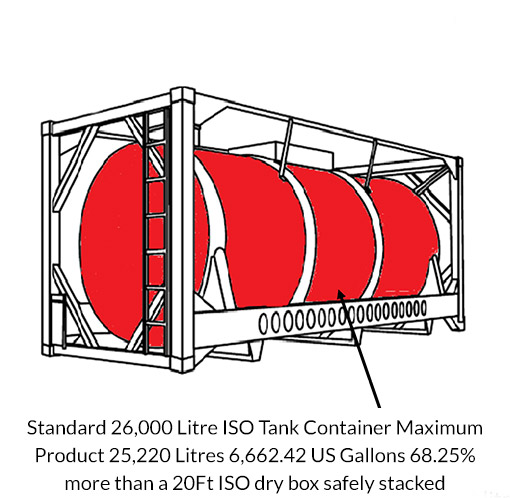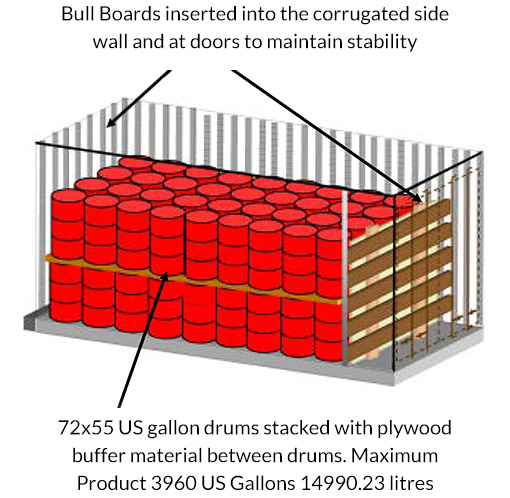T Codes for Liquid Tanks
| T Code | Minimum Shell Thickness Reference Steel |
Relief Provision | Outlet Provision | Minimum Test Pressure (bar) |
| T1 | 6mm | SRV | 2 Shut Off Devices | 1.5 |
| T2 | 6mm | SRV | 3 Shut Off Devices | 1.5 |
| T3 | 6mm | SRV | 2 Shut Off Devices | 2.65 |
| T4 | 6mm | SRV | 3 Shut Off Devices | 2.65 |
| T5 | 6mm | SRV + Rupture Disc + Check Gauge |
Prohibited | 2.65 |
| T6 | 6mm | SRV | 2 Shut Off Devices | 4 |
| T7 | 6mm | SRV | 3 Shut Off Devices | 4 |
| T8 | 6mm | SRV | Prohibited | 4 |
| T9 | 6mm | SRV | Prohibited | 4 |
| T10 | 6mm | SRV + Rupture Disc + Check Gauge |
Prohibited | 4 |
| T11 | 6mm | SRV | 3 Shut Off Devices | 6 |
| T12 | 6mm | SRV + Rupture Disc + Check Gauge |
3 Shut Off Devices | 6 |
| T13 | 6mm | SRV | Prohibited | 6 |
| T14 | 6mm | SRV + Rupture Disc + Check Gauge |
Prohibited | 6 |
| T15 | 6mm | SRV | 3 Shut Off Devices | 10 |
| T16 | 6mm | SRV + Rupture Disc + Check Gauge |
3 Shut Off Devices | 10 |
| T17 | 6mm | SRV + Rupture Disc + Check Gauge |
3 Shut Off Devices | 10 |
| T18 | 6mm | SRV + Rupture Disc + Check Gauge |
3 Shut Off Devices | 10 |
| T19 | 6mm | SRV + Rupture Disc + Check Gauge |
Prohibited | 10 |
| T20 | 8mm | SRV + Rupture Disc + Check Gauge |
Prohibited | 10 |
| T21 | 10mm | SRV | Prohibited | 10 |
| T22 | 10mm | SRV + Rupture Disc + Check Gauge |
Prohibited | 10 |
Specific Gravity
What is Specific Gravity?
The term specific gravity, symbolized sp gr, refers to the ratio of the density of a liquid (or a solid) to the density of water at 4 degrees Celcius.
Unless a Baffle Tank is utilised it is recommended that for both Hazardous (Mandatory) and Non-Hazardous (not Mandatory) be loaded to less than 20% fill or greater than 80% fill. The actual level of fill above 80% is designated by the maximum gross mass of the tank container or the maximum permitted mass of the tank throughout its transit whichever is the least.
Irrespective of the above the tank container may not be filled above the degree of filling designated in IMDG 4.2.1.9. (this is the text which designates the degree of filling required taking in to account thermal expansion)
Also in all cases when loading any Tank Container, sufficient allowance must be made for the expansion of the product. This acknowledges the fact that during transportation the product will experience a range of ambient temperatures. Regulations allow for a maximum 97% fill in some cases however, in line with many operators policies, it is suggested 95% filling ratio should be adopted. Tank Size Choice (in the table below is an “At a Glance” aid only) – If a Baffle tank is utilized the 80% minimum fill rate no longer applies.
| 21 Tonnes | 21 Tonnes | 22.5 Tonnes | 22.5 Tonnes | 24 Tonnes | 24 Tonnes | |
| Max 95% Fill | Max 80% Fill | Max 95% Fill | Max 80% Fill | Max 95% Fill | Max 80% Fill | |
| Size of Tank Required | sp gr, | sp gr, | sp gr, | sp gr, | sp gr, | sp gr, |
| 14000 Litre | 1.58 | 1.88 | 1.69 | 2.00 | 1.80 | 2.14 |
| 15000 Litre | 1.47 | 1.75 | 1.53 | 1.81 | 1.68 | 2.00 |
| 17500 Litre | 1.26 | 1.50 | 1.35 | 1.61 | 1.44 | 1.71 |
| 19000 Litre | 1.16 | 1.38 | 1.25 | 1.48 | 1.33 | 1.58 |
| 20000 Litre | 1.105 | 1.31 | 1.18 | 1.41 | 1.26 | 1.50 |
| 21000 Litre | 1.05 | 1.25 | 1.13 | 1.34 | 1.20 | 1.43 |
| 23000 Litre | 0.96 | 1.14 | 1.03 | 1.22 | 1.10 | 1.30 |
| 24000 Litre | 0.92 | 1.09 | 0.99 | 1.17 | 1.05 | 1.25 |
| 25000 Litre | 0.88 | 1.05 | 0.95 | 1.12 | 1.01 | 1.20 |
| 26000 Litre | 0.85 | 1.01 | 0.91 | 1.08 | 0.97 | 1.15 |
Comparison: Tank Containers vs Drums
Safe Method of Transporting Drums in a 20Ft ISO Container
vs.
Safe Method of Transporting Bulk Liquids in a 20Ft ISO Tank Container
 |
 |
Comparison: Tank Containers vs Flexitanks
There are a number of misconceptions held by some shippers when considering the use of Flexitanks that should be challenged and shippers should be encouraged to check these out for their own benefit.
- “Bags are cheaper” That is often no longer the case and shippers should obtain quotes from Tank Operators to check for themselves.
-
“Bags are safe for the environment” Please ensure that your operator is providing the full service as detailed in their own Industry code of practice. Tank Containers have a proven low carbon footprint.
-
“Are you obtaining the same payload that you are in a Tank Container?”
- “Is my cargo safe?” UK P&I Club Loss Prevention Bulletin
Impact tests of Flexitank inside a 20ft container on rail test bed. Click here to view the potential effect of surge upon vehicles carrying Flexitanks.
